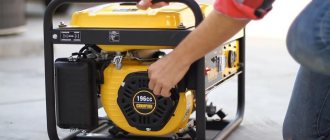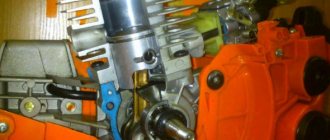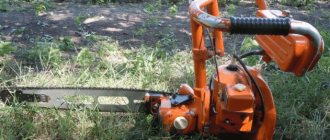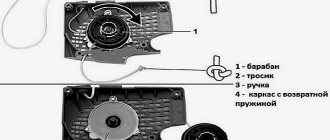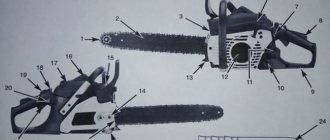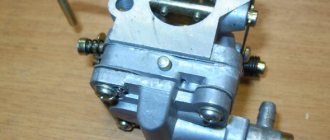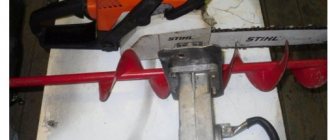Home solutions available
We are trying to start the chainsaw engine and suddenly find ourselves in an unpleasant situation.
A new and fresh chainsaw will do well at work, but after a couple of weeks it will show its capriciousness, managing to shake the hand of its good-natured owner a little. When the engine starts, the kickstarter cord returns with great force, injuring your fingers with the broken plastic handle. The appearance of early ignition on working chainsaws with an electronic high-voltage module is quite rare, but still it is a very unpleasant sensation that occurs when starting the engine of a chainsaw. This problem does not occur often, but only owners sometimes solve it indirectly or immediately. quickly and absolutely radically.
With early ignition, the air/fuel mixture ignites when the engine starts much earlier than the required torque.
With normal effort, we pull the starter cord and hope that the engine will start. But at some point the starter handle breaks out of our hands, injuring our fingers, causing a lot of unpredictable emotions and dissatisfaction with a very clear verbal description of what is happening.
You may also like
- Frigidaire Home Products Lawn MowerBest Types of Car DevicesBest Car BrandsBest Types of Baby Care DevicesBest Baby Care BrandsCar Electronics Types of Video DevicesCar Electronics…
- The Forest game has many useful items and weapons that will help you survive and find your son on an island inhabited by natives. In this guide, we will tell you where to find all the items you need.Where to find a chainsawWith a chainsaw you can…
- Adjusting the carburetor of petrol mowers is done at home. Petrol mowers, like all petrol tools for the garden, are not difficult to maintain equipment. It is possible and necessary to repair and configure without the help of others. For example, adjusting a benzoko carburetor...
- Victory with a chainsaw. Chainsaw Winning: What You Need to Know Stihl Picco Duro Chainsaw Winning Chains The use of carbide saw blades is nothing new: it is widely used on circular saws. But for now, only the Stihl brand offers winning chains...
- Replacing the engine oil of a diesel walk-behind tractor. Walk-behind tractor and everything for it. Repair and . Which oil is better for a walk-behind tractor? Replacing the R-180 engine….
- Why won't my chainsaw start? Frequent malfunctions and ways to eliminate them Chainsaws are simple devices in design and reliable in operation. When handled correctly, breakdowns rarely occur and can be quickly eliminated if the owner knows where to...
Pre-ignition on a chainsaw engine can occur due to the angular movement of the flywheel with magnets when the flywheel rotates on the shaft, when the key is broken, when the engine shaft or plywood of the flywheel hub is broken, when the bushing is loosely pressed. into the bushing inside the flywheel.
Loss of functionality of electronic components in the electronic module circuit can also contribute to the appearance of pre-ignition.
Failure to follow recommendations for the use of spark plugs for a given type of electronic module, neglect of recommendations for the operation of the module itself, or installation of a faulty module from a mass manufacturer
In the example described, the early ignition point appeared on a technically reliable engine, with a normal flywheel angle and a working electronic ignition module. After a successful start, the saw motor ran steadily at medium speed, but lost some power and did not gain enough speed when trying to increase them.
How to adjust a chainsaw?
A carburetor is one of the most important elements of a chainsaw, the main function of which is to enrich the fuel with air and instantly supply the finished mixture to the cylinder of the power unit.
The following signs indicate carburetor malfunctions:
- problems starting a gasoline saw - turning on the engine requires more effort than usual;
- unstable operation of the internal combustion engine in different modes - interruptions are noticeable when the engine rotates at idle, as well as when switching to low and high speeds;
- a sharp increase in the volume of fuel consumed - on average, the amount of fuel increases by 20–30%;
- an increase in the amount of exhaust gases emitted - the volume of gases increases by 50–60%, and the fumes themselves become dark blue, brown or black.
Adjustment of the chainsaw must be carried out on a fully functional and stably running engine. Before starting the setup, you will need to wash or replace the filter, check the integrity of the fuel pipes, and also make sure there are no burrs or other damage on the surface of the cylinder and other parts of the chainsaw’s power unit.
To allow self-adjustment of gas-powered chain tools, the carburetor is equipped with spring-loaded steel screws. Their quantity and marking depend on the brand of chainsaw manufacturer.
The procedure for adjusting the fuel assembly for most chainsaws looks almost the same.
The algorithm of actions should be like this:
- First, you need to turn off the saw and wait until its engine cools down;
- After this, all the screws in the carburetor must be tightened in the clockwise direction until they stop;
- Then each of the screws must be turned a fourth or fifth of a turn in the opposite direction;
- Next, you need to adjust the operation of the power unit at low speeds. To do this, you will need to start turning the corresponding screw slowly in different directions. As soon as the motor begins to operate as quietly and stably as possible, the propeller should be left;
- To adjust idle speed on a chainsaw, you need to pay attention to the chain. If it rotates on the tire, then it is necessary to find the position of the screw at which it will stand still;
- In the end, all that remains is to adjust the operation of the internal combustion engine at high speeds. To do this, you will need to connect a tachometer to the motor cylinder and start rotating the corresponding screw until the indicators on the instrument scale and the instructions in the operating instructions match. For example, if the manual for the saw states that its maximum speed should be 12,500 rpm, then the same number should be indicated on the tachometer scale during adjustment.
To check the operation of the chainsaw after setting it up, you need to turn it off and wait until the engine cools completely. After this, you need to start the engine and begin to smoothly squeeze the accelerator lever. If at the same time the power unit smoothly picks up speed, it means that the saw has been adjusted correctly.
Checking and adjusting the carburetor
In service centers, carburetor adjustment is carried out using special equipment. For each saw, the angles of rotation of the adjusting screws are different (they are indicated in the operating instructions). The need to adjust the carburetor does not arise very often, especially if the saw was purchased from a trusted seller. All of our Husqvarna saws are sent to a service center before being sold, where specialists adjust the speed control.
However, failure to secure the adjusting screws sometimes occurs.
Reasons for failure to adjust the chainsaw carburetor:
- Severe wear on the engine (pistons). In this case, it is necessary to take greater care of repairing the engine, but adjusting the carburetor can improve the functionality of the saw for a certain amount of time.
- Blockage in the carburetor due to damage to the air filter, use of poor quality gasoline and the formation of scale. In such a situation, in addition to adjusting the carburetor, you will also need to flush it.
- Severe vibration of the saw or damage to the protective cover. This happens extremely rarely, but there are still cases.
Signs that indicate the need to adjust the chainsaw carburetor:
- The engine either does not start, or starts and immediately stalls. This occurs due to the use of a poor fuel mixture.
- Significant increase in fuel consumption and emissions. An increase in the amount of exhaust gases indicates that the fuel is not completely burned. The reason for this may be fuel oversaturation.
The carburetor adjustment scheme differs for different models of chainsaws and is described in the operating instructions. However, the general principle remains the same: it is necessary to change the quantity and quality of the fuel mixture supplied to the engine cylinder.
Three screws will help us adjust the carburetor:
- “L” – low, for setting low speeds
- “H” – high, for setting the upper speed
- “T” (“LA”, “S”) – for adjusting the idle speed (models that have only one screw have the “T” screw)
When adjusting the carburetor of a chainsaw, the following rules should be observed:
- Make sure the saw chain is pointing away from you
- Place the saw on a stable, level surface; the cutting part should not touch any objects.
Please note: the instructions indicate the exact angles of rotation of the adjusting screws. Strict adherence to the instructions in the instructions will avoid damage to the engine.
The process of adjusting the carburetor itself includes two points: basic (with the engine not running) and final (with the engine warm and turned on).
Reasons why a chainsaw cuts crookedly?
There are several common factors that impair the balance of a saw's cutting set and ruin the cut line.
These include:
- uneven self-sharpening of cutting teeth - quite often a chainsaw cuts to the side due to a violation of the sequence when sharpening the saw blade. According to the instructions in the instructions, the teeth should be pointed at the same distance. If this rule is violated, the teeth that have been ground down more than others will wear out faster than them. As a result, the chain noticeably moves away from the center, leaving behind a curved, sloppy cutting line;
- operation of a chain whose parameters do not correspond to the busbar - each busbar has its own characteristics, including the width of the groove. The possibility of installing the cutting element on the guide depends on it. If you install a chain with a seat width of 1.3 mm on a bar with a groove of 1.3 mm, then a gap of 0.2 mm will remain. It will lead to uneven movement of the cutting set along the saw blade, as a result of which the chainsaw will cut crookedly;
- increased wear of the cutting teeth of the chain - if the chainsaw moves to the side, this may indicate excessive wear of the chain. To check the cutting element, you need to remove it from the bar and inspect the plane of its contact with the guide bar. If the cutting teeth are truly worn, then the chain needs to be replaced without attempting to sharpen it.
The main reason for accelerated chain wear may be uneven lubrication of the saw set. If it works intermittently, the chain will be lubricated in parts. As a result, teeth that do not receive oil will heat up and wear out faster.
Modifications
In addition to the basic modification of the MS-180, there are improved models:
- Chainsaw Stihl MS-180 C-BE 14.
- Chainsaw Stihl MS-180 16 Picco.
Let's look at each modification separately.
Maintenance
Before use, check:
- chain condition, sharpening;
- chain tension;
- tightening fasteners;
- filling fuel and oil tanks;
- presence of chain lubrication;
- idle speed, etc.
After sawing work the following is done:
- cleaning the chainsaw;
- the chain tension is weakened (certainly);
- chain sharpening (as needed);
- condition of the tire, its wear;
- filter service (if necessary).
Newly-minted owners often get lost and look for materials on how to properly disassemble (assemble) the Stihl 180 chainsaw. We suggest you take a look. where it is shown how to disassemble and reassemble the Stihl 180 chainsaw:
Break-in period for Stihl chainsaws
In general, there is no break-in for the Stihl 180 saw. She is initially ready to work. But the owner of the technology should know and be aware of the following:
- From 4 to 8 full tanks of fuel, the operation of a gasoline saw should be carried out in a gentle mode, not at the full power of the power plant, with frequent breaks to cool the tool.
- The first 60 minutes of operation of the Stihl chainsaw consists of intervals of work and rest: 2 minutes. work, 10 seconds - idle, break. Idling for more than 10 seconds harms the spark plugs, leaving them with carbon deposits.
- It is very important to correctly prepare the fuel mixture from high-quality materials (1/50, AI-92 gasoline and higher, Stihl oil for 2-stroke engines).
Why does the spark plug on a chainsaw flood?
In most cases, the cause of a flooded spark plug is a breakdown or clogging of the carburetor. To disassemble, inspect and wash it, the fuel assembly will need to be removed.
To do this you need:
- Unscrew the 3 metal screws and remove the protective plastic cover;
- Carefully remove the upper foam part of the air filter. In this case, you need to inspect the filter element and make sure that there is no need to wash or replace it;
- Remove the fuel hose, being careful not to tear or bend it;
- Remove the drive rod;
- Carefully disconnect the gas supply pipe and the end of the standard cable.
After disassembling the carburetor, you will need to inspect its membrane. It should be intact and elastic. If the surface of the membrane has become rough, then most likely this is what caused the candle to flood.
Other faulty carburetor elements also need to be replaced, and the remaining old parts should be washed in clean gasoline. After the spare parts have completely dried, you need to assemble the fuel unit and install it on the chainsaw in the reverse order.
Checking the muffler
Do not underestimate the breakdown of this chainsaw assembly. If the muffler becomes clogged, the saw will lose power and, of course, will not start. If the muffler is dismountable, then we disassemble it, inspect it and remove all carbon deposits. In some models, the muffler will have to be unscrewed; after washing, the non-removable muffler should be dried with a hairdryer.
Please note: carbon deposits contain carcinogens that are dangerous to human health; dry cleaning is unacceptable as it can lead to inhalation of these harmful substances.
When we remove the muffler, we plug the engine exhaust hole with a clean rag. The reasons why the muffler may become clogged are:
- Using the wrong fuel mixture (too much oil)
- Using the wrong oil (oil not for two-stroke engines or poor quality oil)
Why does the chain on a chainsaw jam?
The reasons why the chain on the chainsaw does not spin may be damage to the drive sprocket and burning of the tip of the saw guide. First of all, you need to inspect the clutch. If the drive sprocket exhibits uneven tooth wear, cracks, or other defects, the sprocket must be replaced.
If after this the chainsaw chain jams and breaks, then you need to inspect the tire. Burning of its tip, as well as any other part of the guide, leads to increased heating and displacement of the chain. While rotating on the bus, the headset shifted to the side gets wedged. This is evidenced by cases in which the chain stretches on the chainsaw precisely in those places where the operator had previously discovered that the guide was burning and melting.
The cause of blade burning is most often a breakdown of the lubrication system of the cutting set. In this case, it is necessary to carefully inspect the oil pump and also rinse it of debris or frozen lubricant.
Lubrication system design
Depending on the brand of chainsaw, the details of the lubrication system may differ slightly in design, but their total number and connection diagram remain constant.
The main components of the lubrication system are:
- An oil tank is usually located in the engine crankcase.
- The filter element is installed in the tank.
- The oil line is a small diameter hose made of oil-resistant rubber.
- The heart of the system is the oil pump.
- The worm gear transmits force from the motor to the pump.
- The chainsaw tire can also be considered an element of the lubrication system, because it has special holes for supplying oil; by the way, the chain itself is involved in transporting oil and, accordingly, also has certain elements designed specifically to provide lubrication.
How to make a chainsaw run quietly?
Before you find answers to this question, you need to figure out why gas-powered tools began to work louder.
Signs and causes of this problem include:
- sharp shooting sounds or a steady increase in volume when the standard engine picks up speed - a problem with the carburetor;
- periodic knocking sound - contact of adjacent parts;
- a howling sound from the drive side - excessive wear on the drive sprocket;
- Loud whistling noises – problems with the inertia brake.
If there are none of these malfunctions and the operator simply wants to reduce the noise of the running engine, then this can be done by replacing the standard muffler.
For this, prefabricated units from professional chainsaws are best suited. They are designed to muffle the loudest sounds, so they will effectively cope with normalizing the volume of the internal combustion engines of less powerful chainsaws.
Portal about construction
Most people, when first encountering the operation of a chainsaw, wonder how to properly tension the chain on a chainsaw. Installing the chain and adjusting it does not require much time.
A properly tensioned chainsaw chain will ensure longevity of its operation.
In order to answer this question, you should study the structure of a chainsaw. The device consists of several main units that ensure its functioning.
The chainsaw does not cut under load
This breakdown is often encountered by novice gardeners who ignore the need for timely maintenance of their chain tools.
There may be several reasons for the malfunction itself. The first of these is a clogged or ruptured air filter. Dust, small sawdust, and insects constantly accumulate on it - all this blocks the filter’s throughput. To get rid of debris, the filter will need to be thoroughly rinsed by leaving it in a container with clean gasoline for 24 hours. After this, the element must be dried and installed back into the chainsaw structure.
The second reason for tool failure is a malfunction of the fuel filter. Its function is to collect small abrasive substances, sand and additives found in even the highest quality gasoline. All this remains on the filter and over time increases to such an extent that the element loses its ability to pass the fuel itself. In this case, the filter must be washed or replaced.
The third reason for breakdown is the regular use of fuel prepared in the wrong proportion. You can find out about the ratio of gasoline and engine oil from the operating instructions for the gas-powered tool. Violation of the proportion and frequent refueling of the saw with inappropriate fuel lead to deformation of some elements, increased loads on the crankshaft and the entire CPG of the power unit, as well as failure of the built-in bearings.
Features of home renovation
Many experienced users prefer to repair chains themselves. The success of the work performed is determined by the presence of special skills and tools, knowledge of the design features of models for various purposes.
In particular, dismantling and assembling wear-resistant analogues does not create difficulties. The carbide compound is applied only to the cutting edges of the saw links. As for connecting elements and rivets, standard metal is used for their production.
With greater or lesser success, you can rivet chain at home, and if you have the right tools, even in the field. Please note that during subsequent use of a self-repaired headset, special care should be taken. At the first opportunity, it is advisable to have the connection repaired in a hospital.
Why doesn't the chain on my chainsaw rotate?
There can be only two reasons for this common malfunction. The first of them is the jamming of the inertial brake. In this case, the clutch drive star will be blocked by elements of the brake assembly. In this case, the engine itself will continue to operate. To eliminate the malfunction, you need to disassemble the inertial brake of the chainsaw and adjust the position of its parts.
The second reason why the chain does not spin is wear of the ring or jamming of the drive sprocket. Repair of the part is carried out by replacing the ring, if the star is collapsible, or by completely replacing the clutch element.
Trimmers and chainsaws
1) Chainsaw malfunction: The chain rotates almost constantly (the engine, however, does not work stably). Preconditions for the malfunction: The clutch spring has burst. repair at home: Replace the broken clutch spring with a new one (carefully see below “How to remove a chainsaw clutch”). Husqvarna chainsaws have one clutch spring and two weights, Shtil chainsaws have three clutch springs and three weights (cams, sectors). If you cannot find the clutch spring itself, you will have to replace the entire clutch.
2) Chainsaw malfunction : The chain rotates almost constantly, and from time to time extraneous sounds are heard in the clutch. Prerequisites for the malfunction: The clutch cam has broken off (due to overheating) and the clutch spring has flown off. Overheating is indicated by blue clutch cams. Overheating to the point of clutch failure sometimes occurs if you operate a chainsaw with the chain brake on, or in other words, with a dull chain. Repairing a chainsaw yourself: Change the clutch assembly (see carefully below “How to remove a chainsaw clutch”).
Read:
3) Chainsaw malfunction : The clutch often “slips”, and the spring breaks from time to time. Preconditions for the malfunction: Wear of the chainsaw clutch. Repairing a chainsaw in makeshift conditions: Replace the chainsaw clutch assembly.
What problems could there be?
All problems can be divided into two large groups:
- Malfunction in the engine, combustion chamber, fuel supply and exhaust system.
- Breakdown in other components.
The following are typical for engine failure:
- the equipment does not start, stalls;
- does not pump fuel into the primer;
- unstable operation, speed fluctuates;
- It works at idle, and when loaded it can float, stall, or shoot.
If the problem is in other nodes, the following phenomena are noted:
- poor lubrication;
- the brake chain does not work;
- chain wear or breakage;
- drive sprocket wear.
The chain on the chainsaw is jammed, we are looking for the cause. Part 1.
We remove the sprocket and at one time look at the condition of the oil pump. Link to mine.
4. Then you need to lock the crankshaft so that it does not spin when the clutch is unscrewed. To lock the crankshaft, for example, with a huge crank, you need to remove the cover of the manual starter and screw two bolts into the rotor, which allows accounting (software) of the ignition. Or unscrew the spark plug, lower the piston to BDC and stop it there by pushing a rope into the spark plug hole.
Read:
3. Next, unscrew the clutch itself - with the key from the chainsaw kit, as it is also called a wrench for grinder wheels, in other words, with a homemade wrench (for example, from an old tire with 2 bolts) turn the clutch clockwise (there is a left-hand thread), It takes significant effort to break it.
4. Then remove the drum with the drive sprocket from the chainsaw. Changing the clutch drum of a chainsaw is done according to the rule: change two tires - change one drum.
5. Then install the new clutch and tighten it by hand as fully as possible (twist counterclockwise). In this case, you need to lock the crankshaft again so that when turning the clutch you do not break the starter located at the other end of the chainsaw crankshaft.
6. Next, everything is assembled in the reverse order of disassembly.
7. To tighten the clutch on the chainsaw completely, you need to move the chain brake handle forward, start the chainsaw and then release the brake.
The initial stage of repair and restoration work
All known methods of shortening a saw chain require criteria for the rejection of damaged cutting and connecting links and a technology-defined sequence of work operations. The cutting and connecting links are mounted with factory rivets, which in all respects comply with current standards.
The use of homemade components is not recommended in any case. Special rivets for chains are extremely rare on sale, so in most cases the problem is solved by installing the necessary parts removed from the dismantled section of the chain.
The mechanism of operation of the centrifugal automatic clutch of a chainsaw.
When the chainsaw is idling, the clutch weights, although they rotate together with the crankshaft, do not touch the clutch drum (also the clutch cup) because they are tightened by a spring and, accordingly, do not transmit torque from the motor to the saw set. When the engine speed reaches 4000 rpm, the clutch weights are released under the influence of centrifugal force and, resting their outer friction surface against the inner surface of the clutch drum, begin to rotate it, thereby transmitting torque from the motor to the saw set. When the chain stops abruptly during operation (for example, it is jammed), the clutch will not allow the engine to stall, because the friction loads slip in the drum at high speeds, and at speeds below 4000 the loads are already compressed by the spring.
Home page » Chainsaw Works But Chain Doesn't Spin
Advantages of the Stihl MS-180 gasoline saw
Let's talk about the features of the Stihl MS-180 chainsaw:
- lightness of a gasoline saw;
- productivity 2 l. With.;
- belongs to the “hobby class”;
- easy start Ergostart;
- quick chain tension;
- electric ignition;
- four rubber shock absorbers to dampen vibration;
- Quik Stop chain brake;
- sprocket roller insulation;
- the carburetor is not adjustable (only the idle speed is adjusted, the engine speed remains unchanged with factory options);
- the presence of a stabilizing compensator;
- single lever control;
- the chain is strengthened;
- the presence of 2 compression rings on the engine piston instead of 1;
- versatility of the saw:
- durability, reliability.
The following can be called shortcomings:
- noise during operation;
- highest cost;
- limited operating time per day.
Problems starting the engine
It is very important to correctly determine the cause of the malfunction, because otherwise we simply cannot eliminate it. There is a chainsaw, almost new, the engine works great, but the chain does not cut. If you give it gas, the engine reacts, but then tries to stall, because I’m not an expert on how to do it myself. By the way, the chain spins tightly, but the chain doesn’t work. The chain is not on the bar. If, when trying to start the chainsaw, there are no extraneous sounds (knocking, grinding, etc.), then very often it turns out that in fact there is no breakdown. For example, if you start the chainsaw incorrectly and pull the choke for a long time, the engine simply floods and it is very difficult to start it.
In order to properly start a cold chainsaw engine, set the lever or switch to the shutter position. Then you need to pump the mixture into the carburetor, if there is a fuel priming pump. Pull out the starting handle until the engine resistance becomes noticeable, and vigorously pull in amplitude, moving your hand to the side. After two or three such movements, the engine should first start and then stall. If this does not happen, then you need to move the lever to the half-throttle position or simply to the working position and then continue to start the chainsaw in this mode. For many chainsaws, the “half throttle” is automatically locked when the air damper is pulled out. Some models have a key ignition switch; it is important to make sure it is turned on.
If the engine does not start, then the first thing to do is unscrew and inspect the spark plug. At idle, the chain should not move; the chainsaw will lose power or not. There are cases when at a plant in the cold season, the combustion chamber is filled with fuel. Then you also need to unscrew the spark plug, dry the combustion chamber by idling, clean the spark plug, screw it in and repeat the start. If the chainsaw pump does not work, the chain will not spin as a result. It is advisable to immediately check for the presence of a spark - put a cap with a high-voltage wire on the unscrewed spark plug, place it on the cylinder and pull the starter. Visually we observe a frequent blue spark - good. Screw the spark plug into place and start it. If there is no spark, change the spark plug and try again. No again - we check the connection of the high-voltage wire to the spark plug, the coil and the ignition system.
In general, the type of malfunction can be judged by the condition of the spark plug.
- Dry. Most likely, the fuel mixture is not getting into the cylinder. The problem is not in the ignition system, so screw the spark plug back in and check the fuel supply system.
- Wet, heavily splashed with fuel. The reason for the excess fuel mixture lies either in a violation of the starting rules, as described above, or in incorrect carburetor adjustment.
- Covered with black soot. This may indicate the use of low-quality oil, an incorrectly adjusted carburetor, or an incorrectly calculated ratio of gasoline to oil. The spark plug should be washed, removed from carbon deposits with a sharp object (an awl or a needle), the electrodes should be wiped with sandpaper and placed in place.
When checking the spark plug, you need to pay attention to the gap between the electrodes: 0.5 to 0.65 mm is considered normal. A damaged or worn gasket must be replaced.
Final carburetor adjustment
First, warm up the engine for 5-10 minutes (not at high speeds).
Adjusting idle speed
Now, by turning the idle speed screw (T, LA, S) counterclockwise, adjust the minimum number of revolutions at which the engine is stable. The chain should not move. If the engine stops idling, turn the idle speed screw clockwise accordingly. If the chain moves, turn the screw counterclockwise.
To finalize the chainsaw carburetor adjustment, we check the engine for acceleration and maximum speed.
Checking the acceleration
Smoothly press the accelerator and watch how quickly the engine picks up speed from idle to maximum power. If the engine revs slowly, it may be necessary to loosen the L (low speed) screw by turning it slightly counterclockwise (no more than 1/8 turn).
Setting the maximum speed
As mentioned earlier, the maximum speed is adjusted using screw H, the speed increases when turned clockwise, and decreases when turned counterclockwise.
The highest rotation speed of gasoline chain saw engines is between 11,500 and 15,000 rpm, depending on the model. Higher speed is dangerous for the engine, which will prevent it from starting. The maximum speed can be determined by interruptions in the ignition. If any appear, turn screw H counterclockwise.
Check the chainsaw again at idle speed
Once we have adjusted the acceleration and maximum speed, we again check the engine at idle speed. We will know that we have adjusted the carburetor correctly if:
- The chain does not move at idle
- The engine revs up
- The sound of a running engine is reminiscent of a four-stroke internal combustion engine.
If at least one of these conditions is not met, the adjustment should be repeated (excluding the basic stage).
The feasibility of self-repair
Experts advise riveting and repairing a damaged chain using the technical potential of a service workshop. Despite manufacturers' assurances about the problems and difficulties of self-repair, a significant portion of users prefer to learn techniques for restoring the functionality of saw sets on their own.
- the owner lives at a great distance from service and maintenance points;
- high cost of repair services provided;
- lack of necessary equipment.
Compensating for natural chain wear by shortening is neither advisable nor safe. Operating a saw set with a stretched chain is inevitably accompanied by:
- forced wear of the tire and drive sprocket;
- increased load on the engine;
- increased risk of injury from sawing work of various levels of complexity.
Sources:
https://opilah.com/kak-ukorotit-tsep-na-benzopile/
